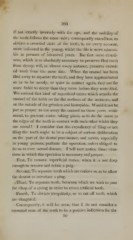Page 397 - My FlipBook
P. 397
393
if not exactly inversely with the age, and the mobility of
the teeth follows the same rule ; consequently extraction, to
obviate a crowded state of the teeth, is, on every account,
more indicated in the young, whilst the file is more admissi-
ble in persons of advanced years. But that same cleanli-
ness, which is so absolutely necessary to preserve filed teeth
from decay, will, in almost every instance, preserve crowd-
ed teeth from the same fate. When the enamel has been
filed away to separate the teeth, and they have approximated
so as to be nearly, or quite in contact again, they are far
more liable to decay than they were before they were filed.
We noticed that kind of superficial caries which attacks the
enamel of the teeth on the flat surfaces of the incisores, and
on the outside of the grinders and bicuspides. Would it not be
just as proper to cut away the enamel on these parts, while
sound, to prevent caries taking place, as to do the same to
the edges of the teeth in contact with each other whilst they
are sound ? I consider that the expediency of filing or not
filing the teeth ought to be a subject of serious deliberation
on the part of the dental practitioner, and never, especially
in young persons, perform the operation, unless obliged to
do so to cure actual disease. I will now notice those situa-
tions in which this operation is necessary and proper.
First, To remove superficial caries, when it is not deep
enough to receive and retain a pulg.
Second, To separate teeth which are carious so as to allow
the dentist to introduce a plug.
Third, To separate teeth, between which we wish to pass
the clasp of a spring in order to retain artificial teeth.
Fourth, To obviate irregularity, or to cut off teeth which
are elongated.
Consequently, it will be seen, that I do not consider a
crowded state of the teeth to be a positive indication for the
50


